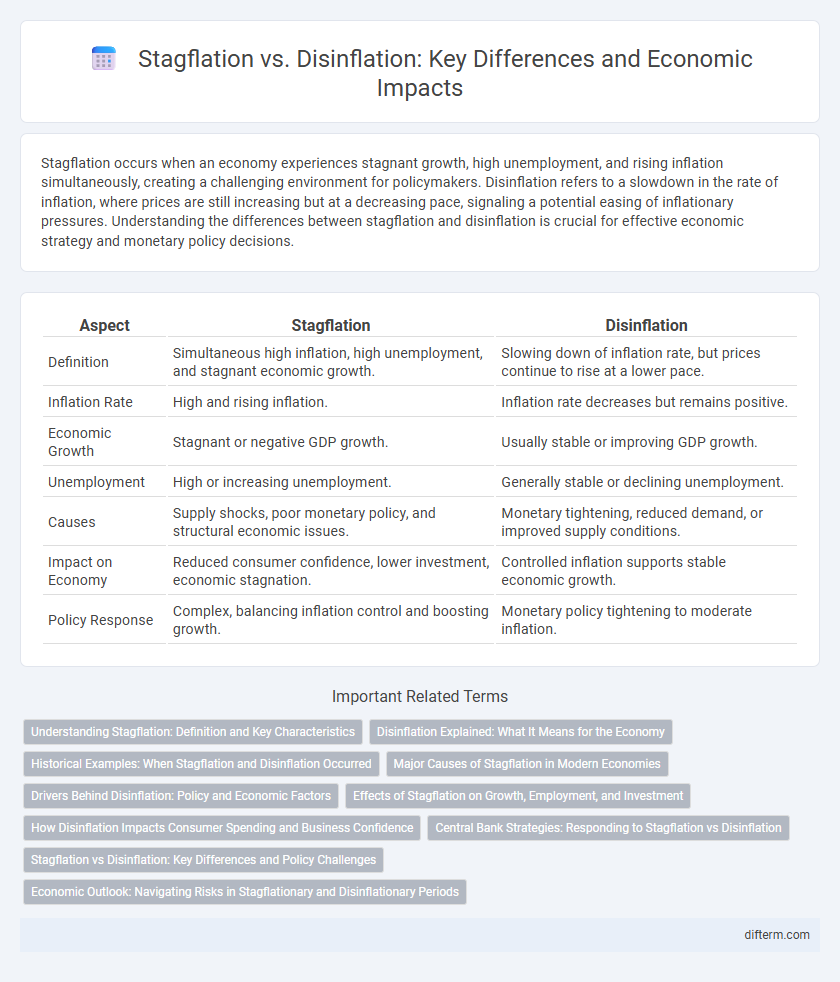Stagflation occurs when an economy experiences stagnant growth, high unemployment, and rising inflation simultaneously, creating a challenging environment for policymakers. Disinflation refers to a slowdown in the rate of inflation, where prices are still increasing but at a decreasing pace, signaling a potential easing of inflationary pressures. Understanding the differences between stagflation and disinflation is crucial for effective economic strategy and monetary policy decisions.
Table of Comparison
| Aspect | Stagflation | Disinflation |
|---|---|---|
| Definition | Simultaneous high inflation, high unemployment, and stagnant economic growth. | Slowing down of inflation rate, but prices continue to rise at a lower pace. |
| Inflation Rate | High and rising inflation. | Inflation rate decreases but remains positive. |
| Economic Growth | Stagnant or negative GDP growth. | Usually stable or improving GDP growth. |
| Unemployment | High or increasing unemployment. | Generally stable or declining unemployment. |
| Causes | Supply shocks, poor monetary policy, and structural economic issues. | Monetary tightening, reduced demand, or improved supply conditions. |
| Impact on Economy | Reduced consumer confidence, lower investment, economic stagnation. | Controlled inflation supports stable economic growth. |
| Policy Response | Complex, balancing inflation control and boosting growth. | Monetary policy tightening to moderate inflation. |
Understanding Stagflation: Definition and Key Characteristics
Stagflation occurs when an economy experiences stagnant growth, high unemployment, and rising inflation simultaneously, creating a challenging environment for policymakers. Key characteristics include persistent inflation despite weak demand, supply-side shocks such as oil price hikes, and reduced consumer spending power. This phenomenon complicates traditional economic responses, as measures to control inflation may exacerbate unemployment and slow growth further.
Disinflation Explained: What It Means for the Economy
Disinflation refers to a decrease in the rate of inflation, indicating that prices are rising more slowly but still increasing. It signals a moderating economy where consumer demand and spending growth are stabilizing without causing deflation. Policymakers often view disinflation as a positive sign of controlled inflation, fostering economic stability and extended purchasing power for consumers.
Historical Examples: When Stagflation and Disinflation Occurred
Stagflation notably occurred during the 1970s oil crisis, when rising inflation coincided with stagnating economic growth and high unemployment in many Western economies, particularly the United States. Disinflation, characterized by a slowdown in inflation rates without causing deflation, was experienced in the early 1980s under Federal Reserve policies aimed at controlling hyperinflation in the US. Historical episodes of stagflation and disinflation illustrate the complex challenges faced by policymakers attempting to balance inflation control with economic growth.
Major Causes of Stagflation in Modern Economies
Stagflation in modern economies is primarily caused by supply shocks, such as sudden increases in oil prices, which disrupt production costs and lead to rising inflation alongside stagnant growth. Structural inefficiencies including labor market rigidities and regulatory burdens further exacerbate low economic output while inflationary pressures persist. Monetary policy missteps, like excessive money supply growth, also play a significant role in fueling stagflation conditions.
Drivers Behind Disinflation: Policy and Economic Factors
Disinflation is primarily driven by tight monetary policies such as increased interest rates and reduced money supply, which curb inflationary pressures by limiting consumer spending and borrowing. Economic factors include improved productivity and supply chain stability, which enhance output without accelerating price growth. Fiscal policies aimed at reducing budget deficits can also contribute by dampening demand, thereby supporting a controlled inflation environment.
Effects of Stagflation on Growth, Employment, and Investment
Stagflation causes stagnant economic growth, high unemployment, and reduced investment due to persistent inflation combined with low demand. Businesses face higher costs and uncertainty, leading to delayed expansion and lower job creation. Consumer purchasing power decreases, further dampening economic activity and investment confidence.
How Disinflation Impacts Consumer Spending and Business Confidence
Disinflation, characterized by a slowing rate of inflation, typically bolsters consumer spending as purchasing power stabilizes, encouraging more predictable and sustained consumption patterns. Businesses tend to gain confidence during disinflation periods due to reduced input cost volatility and improved price stability, facilitating better long-term investment planning. Unlike stagflation, which combines stagnant growth with inflation, disinflation supports gradual economic recovery by alleviating inflationary pressures without triggering recessionary impacts.
Central Bank Strategies: Responding to Stagflation vs Disinflation
Central banks combat stagflation through tight monetary policies, raising interest rates to control inflation despite the risk of slowing economic growth. In contrast, disinflation prompts a balanced approach with cautious interest rate adjustments aimed at sustaining economic expansion while gradually reducing inflation. Strategic communication plays a crucial role in managing market expectations during both stagflation and disinflation periods.
Stagflation vs Disinflation: Key Differences and Policy Challenges
Stagflation is characterized by persistent high inflation, stagnant economic growth, and rising unemployment, whereas disinflation refers to a slowdown in the rate of inflation without causing deflation or significant economic contraction. Stagflation presents complex policy challenges as traditional monetary tools to curb inflation can exacerbate unemployment and slow growth, while disinflation allows for more manageable adjustments through cautious interest rate hikes. Addressing stagflation often requires coordinated fiscal and monetary policies to stabilize prices and stimulate growth simultaneously.
Economic Outlook: Navigating Risks in Stagflationary and Disinflationary Periods
Stagflation presents a complex challenge with simultaneous high inflation and stagnant growth, leading to increased unemployment and reduced consumer spending power. In contrast, disinflation signals a slowdown in inflation rates, which can stabilize prices but may also indicate weakening demand and economic downturn. Policymakers must balance monetary tightening to control inflation while avoiding excessive restrictions that could deepen recession risks in both scenarios.
Stagflation vs Disinflation Infographic

 difterm.com
difterm.com